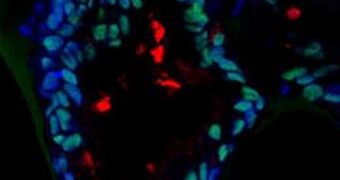A team of biotechnology experts managed to create three-dimensional (3D) organ tissue using stem cells, by forcing them to undergo specific embryonic development stages, and guiding their transformation. The end results are batches of 3D intestine tissue, that feature all cell types in the gut.
Obtaining all major cell types in this manner marks the first time embryonic stem cells (ESC) are coaxed into creating a 3D organ inside cultures, the group behind the new investigation says.
The work was conducted by experts at the Cincinnati Children's Hospital Medical Center, in Ohio, who published a complete description of the research in the latest issue of the top scientific journal Nature.
Developmental biologist and lead study investigator James Wells says that investigating the molecular basis of human intestinal development is now possible in the controlled confines of scientific labs.
Experts may also study the onset of intestinal diseases, he adds, in a way that has never been possible before. This could allow them to design new drugs, that would be absorbed faster and more thoroughly.
Additionally, it may become possible in the near future to develop technologies enabling scientists to grow a new organ from a patient's stem cells. This would make transplants routine procedures.
If a patient gets a transplant featuring their own cells, then there would be no risk of rejection, as the body would immediately recognize its own cells. There would also be no need for immunosuppressive drugs, which hamper the body's natural defenses.
Transplant patients need to be administered such drugs in order to prevent their bodies from rejecting foreign implants, but a suppressed immune system means they are more opened to infections by bacteria, microbes and other pathogens.
“This is really a major advance in the field because it provides an experimental system for studying the development of the human intestine,” explains scientist Steven Cohn, quoted by Nature News.
“This will allow one to study human organ development in the test tube in a way that we haven't been able to do before,” adds the expert, who is a University of Virginia School of Medicine in Charlottesville gastroenterologist.
“Their ability to generate all of the cell types in the intestine was very impressive. This is really the first time that I'm aware of that we've been able to recapitulate most of the development of an organ in a test tube from a human pluripotent stem cell,” the scientist comments.
“This is a good first step toward generating replacement tissue for people with degenerative diseases of the intestine,” Wells adds. He explains that there are however hurdles to conducting such research.
The obstacles don't necessarily come from technical difficulties or other such things, but rather from the fact that policies in the US are excessively strict on ESC, which hinders serious advancements in this field that could save millions.

 14 DAY TRIAL //
14 DAY TRIAL //